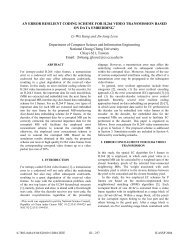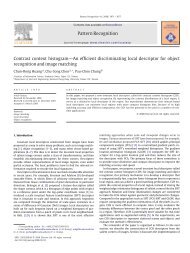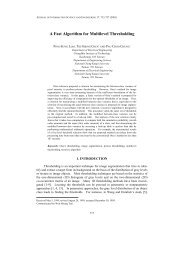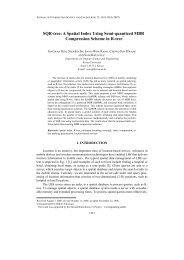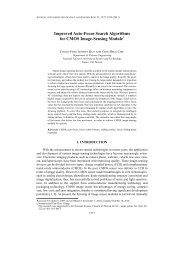Design, Implementation, and Performance Evaluation of Flash ...
Design, Implementation, and Performance Evaluation of Flash ...
Design, Implementation, and Performance Evaluation of Flash ...
You also want an ePaper? Increase the reach of your titles
YUMPU automatically turns print PDFs into web optimized ePapers that Google loves.
FLASH MEMORY-BASED FILE SYSTEM ON CHIP<br />
Linux kernel<br />
FTL<br />
<strong>Flash</strong><br />
Memory<br />
Compact<strong>Flash</strong><br />
Host<br />
Virtual File System Layer<br />
FSOC<br />
File System<br />
Device Driver<br />
Application<br />
FSOC Stub<br />
FSOC<br />
File System<br />
FTL<br />
<strong>Flash</strong><br />
Memory<br />
FSOC<br />
Fig. 9. Host implementation supporting FSOC <strong>and</strong> Compact<strong>Flash</strong>.<br />
storage device. For the FSOC, a stub was implemented <strong>and</strong> added to the kernel. The file<br />
system used in the FSOC prototype was ported to the Linux kernel to operate the conventional<br />
storage device. Therefore, the file system in the host is exactly the same as the<br />
file system in FSOC. This was done for the purpose <strong>of</strong> fair comparison. For all the experiments,<br />
the PCMCIA interface was used <strong>and</strong> the host clock rate is fixed at 56Mhz<br />
unless otherwise stated. The NAND flash memory we used has read b<strong>and</strong>width <strong>of</strong><br />
42MB/sec <strong>and</strong> written b<strong>and</strong>width <strong>of</strong> 2.56MB/sec. The data transfer rate <strong>of</strong> the bus ranges<br />
between 700KB/sec <strong>and</strong> 1MB/sec depending on the host clock speed.<br />
5.1 Computation Time <strong>and</strong> I/O Time <strong>of</strong> an Application<br />
There are two performance implications as we move the file system from the host to<br />
the storage device. The first is that the host CPU burden is reduced as the file system<br />
code is no longer executed. This leaves more room for other CPU activities including<br />
application code execution in the host system that may be executed in parallel with the<br />
file system code that is executed in the FSOC, having a positive influence on performance.<br />
On the other h<strong>and</strong>, the CPU in the FSOC, which is generally slower than the one in<br />
the host system, now has more work to do than before, having a negative influence on<br />
performance.<br />
In this section, we show how the ratio between the computation time <strong>and</strong> the I/O<br />
time <strong>of</strong> the application influences the overall performance <strong>of</strong> FSOC. For this purpose, we<br />
perform experiments with a synthetic workload that varies the ratio between the computation<br />
time <strong>and</strong> the I/O time. Fig. 10 shows the pseudo code for the synthetic workload.<br />
We used non-blocking read for parallel execution <strong>of</strong> I/O processing <strong>and</strong> computation. I/O<br />
processing <strong>and</strong> computation is performed in 4KB data units. Step 5 in Fig. 10 is a dummy<br />
loop that does not perform any useful computation, but was inserted to control the computation<br />
time so we could control the computation <strong>and</strong> I/O time ratio.<br />
The results from this experiment are shown in Fig. 11 (a), where the x-axis is the<br />
initial value <strong>of</strong> the counter variable <strong>and</strong> the y-axis is the total execution time <strong>of</strong> the synthetic<br />
application. ‘FSOC’ denotes the results for the FSOC prototype <strong>and</strong> ‘Conv’ denotes<br />
the results for the conventional storage device. When the initial value <strong>of</strong> the counter<br />
1877




